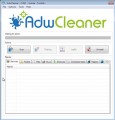The Ransomware Attack Warning Alert is a misleading ‘ad’ web page that created to scare you into thinking that your system have a lot of heavy. So call to Microsoft Support unnecessary anyway. A telephone, which is given in the message is a fake MS Tech Support.
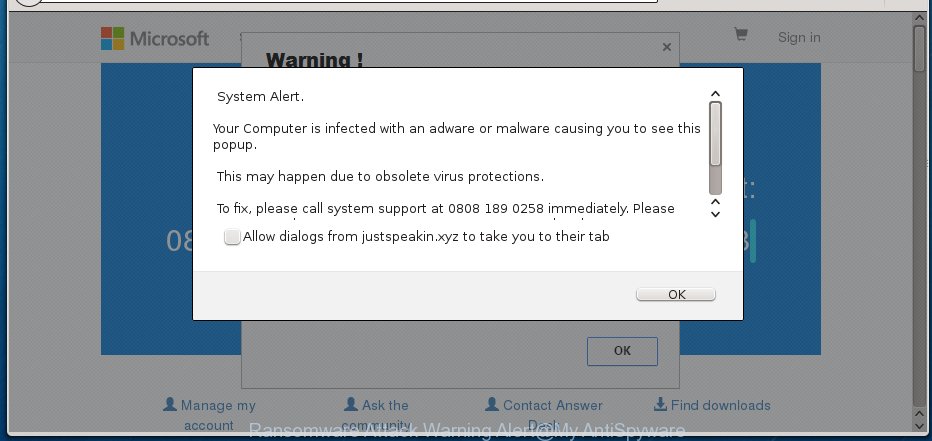
If Ransomware Attack Warning Alert alert popping up in your browser then this might be a sign that your computer is infected with adware (sometimes named ‘ad-supported’ software). It is a type of malicious programs that designed to display tons of unwanted pop up ads. Unlike viruses, the ad supported software will not delete or infect your files, but its actions will cause some problems with your web browser. This is because, it’ll infect your system, get full access to your browsers like Google Chrome, Firefox, Microsoft Internet Explorer and MS Edge and be able to change their settings. Of course, it did not ask you for permission and do it secretly as possible. Once your web-browser settings will be replaced, you will be rerouted to unwanted advertisements, some of which can lead to harmful or misleading web pages. For this reason, we suggest that you begin the clean up of your machine ASAP and thereby remove Ransomware Attack Warning Alert fake pop up from your web-browser.
Table of contents
- What is Ransomware Attack Warning Alert
- Ransomware Attack Warning Alert fake pop-up removal guidance
- How to block Ransomware Attack Warning Alert pop-up
- Tips to prevent Ransomware Attack Warning Alert fake pop-up
- To sum up
Most often, the ad supported software affects the most common browsers such as the Google Chrome, Internet Explorer, Mozilla Firefox and Edge. But such the malicious software as well may infect another web browsers by changing its shortcuts (adding an argument such as ‘http://site.address’ into Target field of a web-browser’s shortcut). So every time you open the web-browser, it’ll redirect to the annoying Ransomware Attack Warning Alert page. Even if you setup a new start page, an unwanted web-site will be the first thing you see when you open the Chrome, Firefox, Microsoft Internet Explorer and MS Edge.
We recommend you to delete adware and clean your computer from Ransomware Attack Warning Alert popups as quickly as possible, until the presence of the adware has not led to even worse consequences. You need to follow the few simple steps below that will help you to completely get rid of the reroute to Ransomware Attack Warning Alert undesired page, using only the built-in MS Windows features and a few of specialized free malicious software removal utilities.
Ransomware Attack Warning Alert fake pop-up removal guidance
Even if you’ve the up-to-date classic antivirus installed, and you’ve checked your PC for malware and removed anything found, you need to do the guidance below. The Ransomware Attack Warning Alert fake popup error removal is not simple as installing another antivirus. Classic antivirus software are not made to run together and will conflict with each other, or possibly crash Microsoft Windows. Instead we recommend complete the manual steps below after that run Zemana Anti-malware, Malwarebytes or AdwCleaner, which are free software dedicated to find and delete adware that causes internet browsers to open misleading Ransomware Attack Warning Alert pop-up scam. Run these utilities to ensure the adware is removed.
Remove Ransomware Attack Warning Alert popup without any utilities
Most common ad supported software may be uninstalled without any antivirus programs. The manual adware removal is post tutorial that will teach you how to get rid of the Ransomware Attack Warning Alert popup scam.
Uninstall suspicious and potentially unwanted software using MS Windows Control Panel
We recommend that you start the machine cleaning process by checking the list of installed software and remove all unknown or suspicious software. This is a very important step, as mentioned above, very often the malicious programs such as ad-supported software and hijacker infections may be bundled with free software. Remove the unwanted programs can remove the undesired advertisements or web browser redirect.
Windows 8, 8.1, 10
First, click Windows button
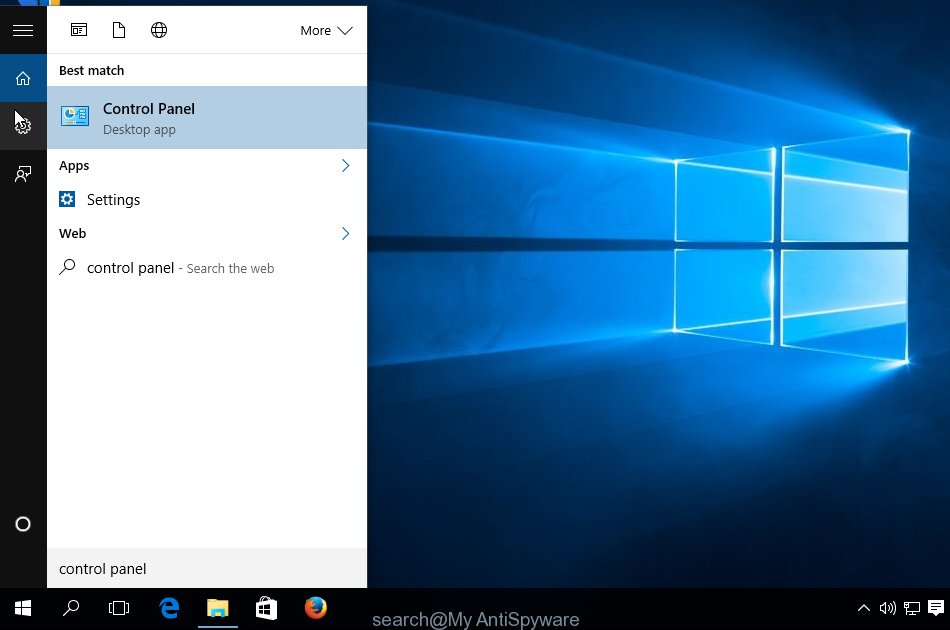
When the ‘Control Panel’ opens, click the ‘Uninstall a program’ link under Programs category as shown below.
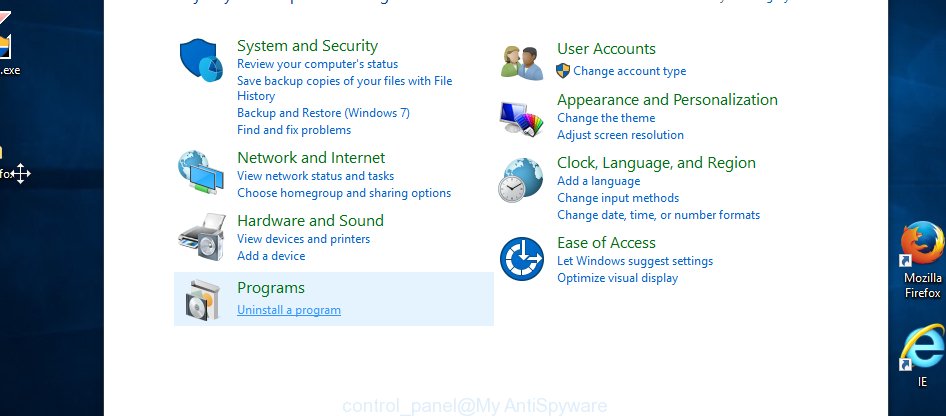
You will see the ‘Uninstall a program’ panel as on the image below.

Very carefully look around the entire list of programs installed on your personal computer. Most likely, one or more of them are responsible for the appearance of popup ads and internet browser redirect to the annoying Ransomware Attack Warning Alert site. If you have many programs installed, you can help simplify the search of harmful software by sort the list by date of installation. Once you have found a suspicious, unwanted or unused program, right click to it, after that press ‘Uninstall’.
Windows XP, Vista, 7
First, click ‘Start’ button and select ‘Control Panel’ at right panel as on the image below.
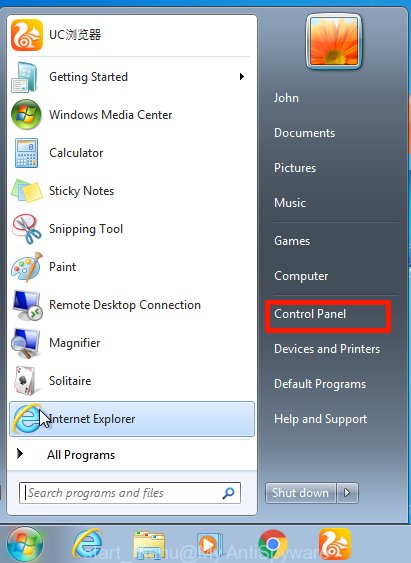
After the Windows ‘Control Panel’ opens, you need to press ‘Uninstall a program’ under ‘Programs’ as on the image below.
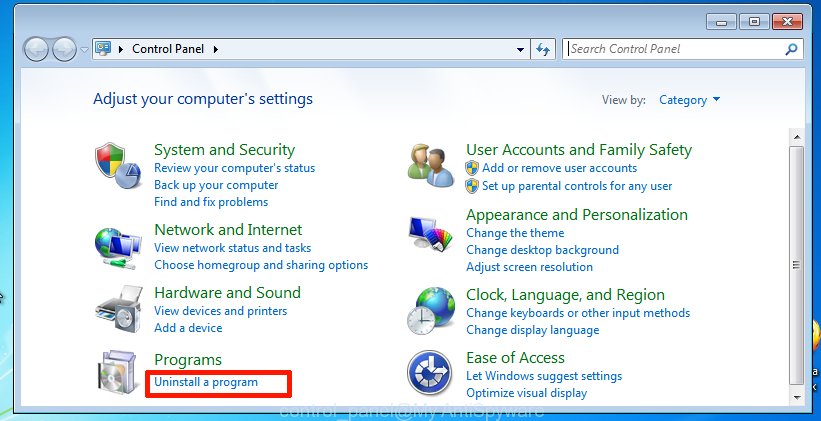
You will see a list of software installed on your personal computer. We recommend to sort the list by date of installation to quickly find the applications that were installed last. Most likely they responsibility for the appearance of popup advertisements and internet browser redirect. If you are in doubt, you can always check the program by doing a search for her name in Google, Yahoo or Bing. When the application which you need to delete is found, simply click on its name, and then click ‘Uninstall’ as shown on the screen below.
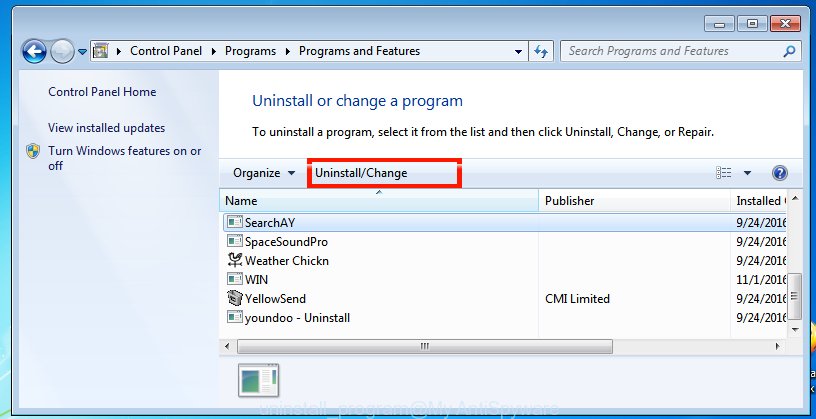
Fix web browser shortcuts, modified by ad supported software
Important to know, most anti-malware software which are able to remove adware, but unable to detect and recover modified shortcuts. So, you need to fix the desktop shortcuts for your Mozilla Firefox, Google Chrome, Internet Explorer and MS Edge web browsers manually.
Right click to a desktop shortcut for your internet browser. Choose the “Properties” option. It will open the Properties window. Select the “Shortcut” tab here, after that, look at the “Target” field. The ad-supported software can modify it. If you are seeing something like “…exe http://site.address” then you need to remove “http…” and leave only, depending on the web browser you are using:
- Google Chrome: chrome.exe
- Opera: opera.exe
- Firefox: firefox.exe
- Internet Explorer: iexplore.exe
Look at the example as shown in the figure below.

Once is finished, click the “OK” button to save the changes. Please repeat this step for web browser shortcuts which redirects to an annoying web-sites. When you have completed, go to next step.
Remove Ransomware Attack Warning Alert pop-up from Internet Explorer
If you find that Internet Explorer web browser settings like home page, new tab page and default search provider having been changed by adware that shows misleading Ransomware Attack Warning Alert fake pop up on your PC system, then you may restore your settings, via the reset internet browser procedure.
First, launch the Internet Explorer, click ![]() ) button. Next, click “Internet Options” as on the image below.
) button. Next, click “Internet Options” as on the image below.

In the “Internet Options” screen select the Advanced tab. Next, press Reset button. The Internet Explorer will display the Reset Internet Explorer settings prompt. Select the “Delete personal settings” check box and press Reset button.

You will now need to restart your system for the changes to take effect. It will remove Ransomware Attack Warning Alert fake pop-up, disable malicious and ad-supported web browser’s extensions and restore the Microsoft Internet Explorer’s settings such as newtab, home page and search engine by default to default state.
Remove Ransomware Attack Warning Alert popup from Chrome
If your Chrome web-browser is rerouted to undesired Ransomware Attack Warning Alert web-page, it may be necessary to completely reset your web browser program to its default settings.
Open the Chrome menu by clicking on the button in the form of three horizontal stripes (![]() ). It will display the drop-down menu. Next, click to “Settings” option.
). It will display the drop-down menu. Next, click to “Settings” option.

Scroll down to the bottom of the page and click on the “Show advanced settings” link. Now scroll down until the Reset settings section is visible, like below and click the “Reset settings” button.
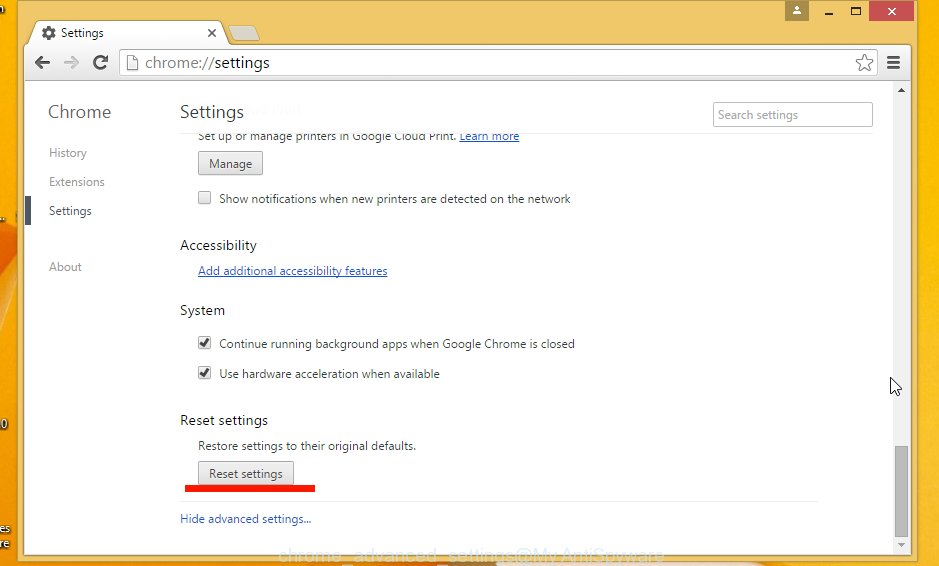
Confirm your action, click the “Reset” button.
Delete Ransomware Attack Warning Alert fake pop-up from FF
The Mozilla Firefox reset will keep your personal information such as bookmarks, passwords, web form auto-fill data, recover preferences and security settings, delete redirections to unwanted Ransomware Attack Warning Alert page and adware.
First, open the Mozilla Firefox and click ![]() button. It will show the drop-down menu on the right-part of the web browser. Further, press the Help button (
button. It will show the drop-down menu on the right-part of the web browser. Further, press the Help button (![]() ) like below
) like below
.

In the Help menu, select the “Troubleshooting Information” option. Another way to open the “Troubleshooting Information” screen – type “about:support” in the internet browser adress bar and press Enter. It will open the “Troubleshooting Information” page like below. In the upper-right corner of this screen, click the “Refresh Firefox” button.

It will show the confirmation prompt. Further, click the “Refresh Firefox” button. The Firefox will begin a task to fix your problems that caused by the ‘ad supported’ software that causes browsers to display misleading Ransomware Attack Warning Alert pop-up. When, it is complete, click the “Finish” button.
Remove unwanted Scheduled Tasks
Once installed, the ad-supported software can add a task in to the Windows Task Scheduler Library. Due to this, every time when you launch your personal computer, it will show Ransomware Attack Warning Alert intrusive web-site. So, you need to check the Task Scheduler Library and get rid of all malicious tasks which have been created by malicious software.
Press Windows and R keys on your keyboard simultaneously. It will display a dialog box which called Run. In the text field, type “taskschd.msc” (without the quotes) and press OK. Task Scheduler window opens. In the left-hand side, click “Task Scheduler Library”, as on the image below.
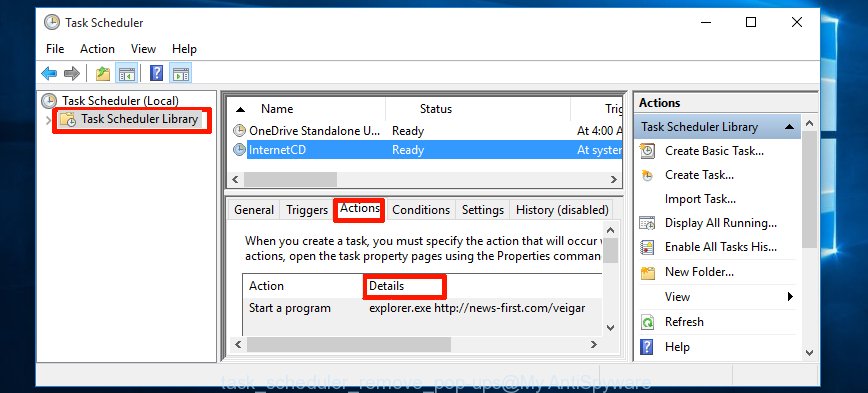
Task scheduler, list of tasks
In the middle part you will see a list of installed tasks. Select the first task, its properties will be open just below automatically. Next, press the Actions tab. Necessary to look at the text which is written under Details. Found something such as “explorer.exe http://site.address” or “chrome.exe http://site.address” or “firefox.exe http://site.address”, then you need get rid of this task. If you are not sure that executes the task, then google it. If it is a component of the malicious program, then this task also should be removed.
Further click on it with the right mouse button and select Delete as shown below.

Task scheduler, delete a task
Repeat this step, if you have found a few tasks that have been created by ‘ad-supported’ applications. Once is complete, close the Task Scheduler window.
How to get rid of Ransomware Attack Warning Alert fake popup error with freeware
Many antivirus companies have made software that help detect ‘ad supported’ software and thereby remove Ransomware Attack Warning Alert from the Chrome, Internet Explorer, FF and MS Edge web browsers. Below is a a few of the free applications you may want to run. Your computer may have a large amount of potentially unwanted applications, adware and browser hijackers installed at the same time, so we recommend, if any unwanted or harmful application returns after rebooting the PC, then start your personal computer into Safe Mode and use the anti-malware utility again.
Scan and clean your web browser of Ransomware Attack Warning Alert pop-up with Zemana Anti-malware
We recommend using the Zemana Anti-malware that are completely clean your PC system of the adware. The tool is an advanced malicious software removal program made by (c) Zemana lab. It’s able to help you get rid of potentially unwanted applications, hijackers, malware, toolbars, ransomware and adware that causes misleading Ransomware Attack Warning Alert fake pop up on your internet browser.
Download Zemana Anti-Malware on your PC by clicking on the link below. Save it on your desktop.
165074 downloads
Author: Zemana Ltd
Category: Security tools
Update: July 16, 2019
After the downloading process is finished, close all windows on your computer. Further, start the install file named Zemana.AntiMalware.Setup. If the “User Account Control” prompt pops up like below, press the “Yes” button.
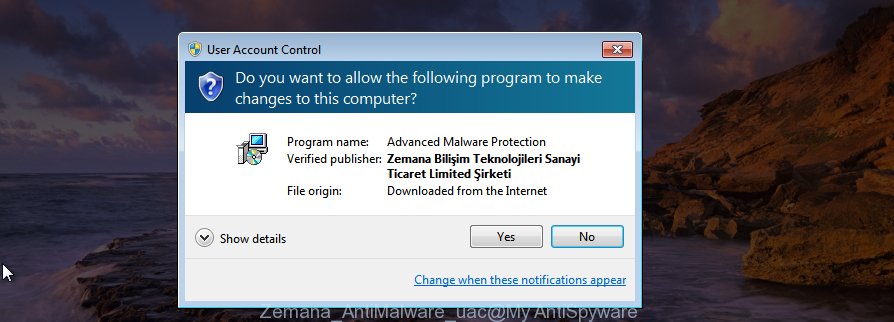
It will open the “Setup wizard” which will help you install Zemana Anti Malware on the PC system. Follow the prompts and do not make any changes to default settings.
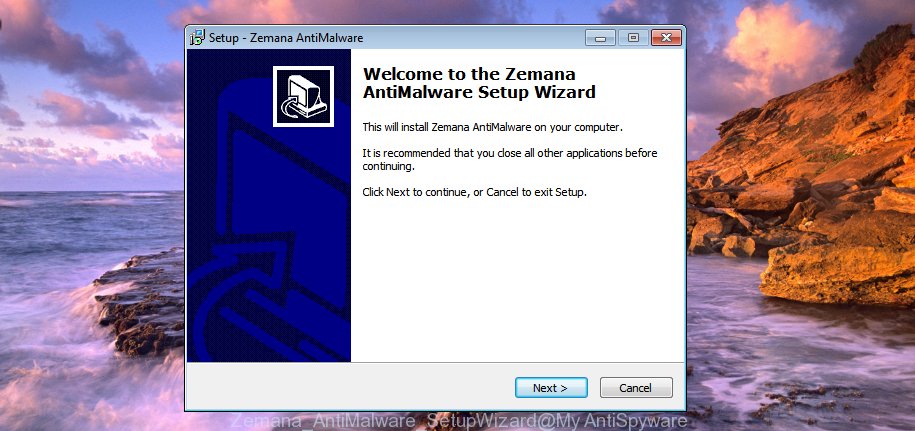
Once installation is finished successfully, Zemana Anti-Malware will automatically run and you can see its main window as shown below.
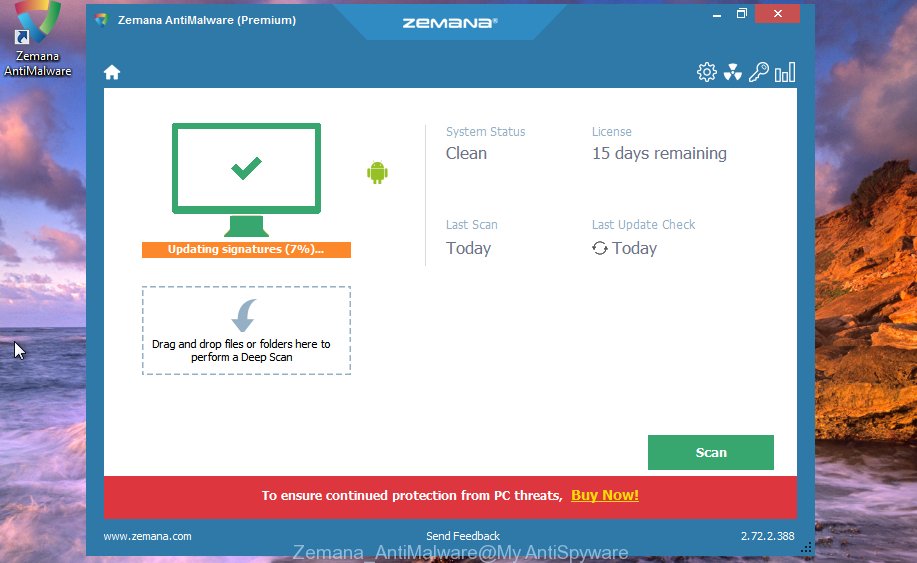
Next, click the “Scan” button . This will start scanning the whole system to find out ad supported software that causes multiple misleading Ransomware Attack Warning Alert alerts and popups. This procedure can take some time, so please be patient. While the tool is checking, you can see count of objects it has identified either as being malware.

Once the scan is finished, it will display a list of all items found by this tool. You may move threats to Quarantine (all selected by default) by simply press “Next” button.
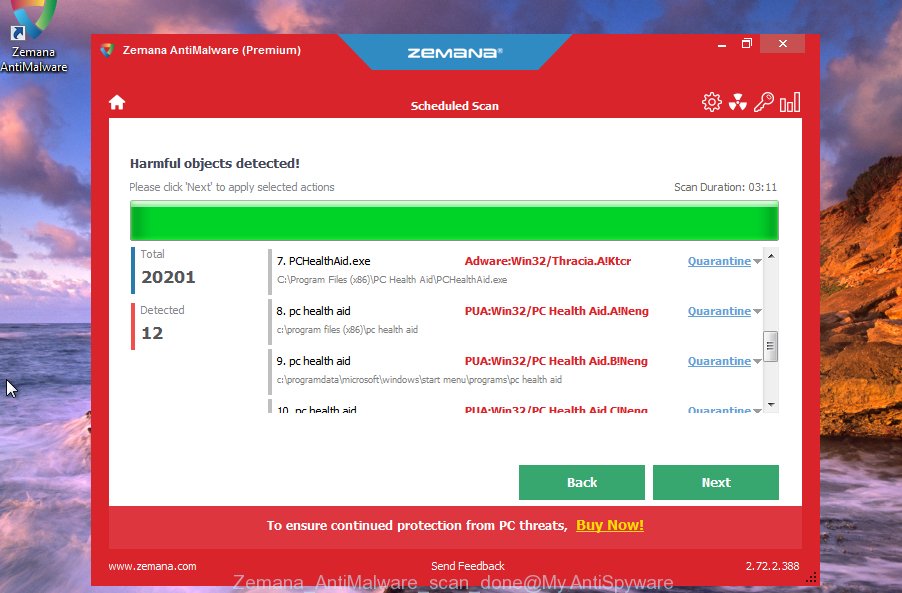
The Zemana Anti-Malware will start to delete ad-supported software that shows misleading Ransomware Attack Warning Alert pop up scam on your machine. When the task is done, you can be prompted to restart your computer.
Remove Ransomware Attack Warning Alert pop up scam with Malwarebytes
We recommend using the Malwarebytes Free which are completely clean your system of the ad supported software. The free utility is an advanced malware removal program developed by (c) Malwarebytes lab. This application uses the world’s most popular anti malware technology. It’s able to help you remove intrusive Ransomware Attack Warning Alert pop-up scam from your web-browsers, PUPs, malware, browser hijacker infections, toolbars, ransomware and other security threats from your computer for free.
Download Malwarebytes from the link below.
327297 downloads
Author: Malwarebytes
Category: Security tools
Update: April 15, 2020
After the downloading process is done, close all applications and windows on your machine. Open a directory in which you saved it. Double-click on the icon that’s called mb3-setup as shown below.
![]()
When the install begins, you will see the “Setup wizard” that will help you install Malwarebytes on your machine.
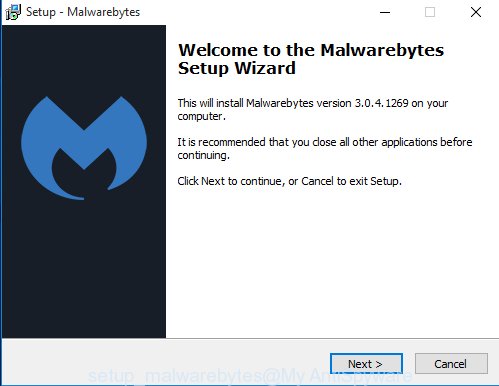
Once installation is finished, you will see window like below.
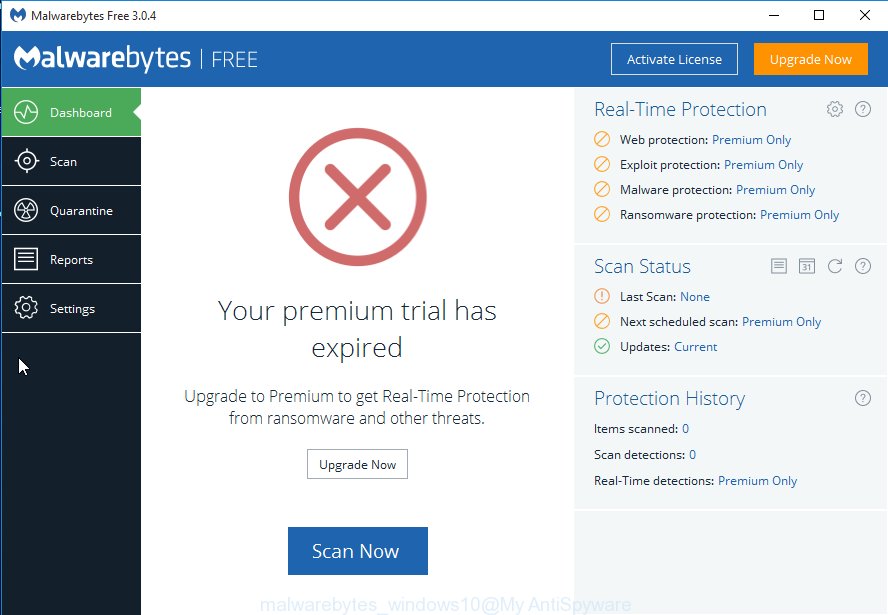
Now click the “Scan Now” button . This will start scanning the whole personal computer to find out ‘ad supported’ software that causes multiple misleading Ransomware Attack Warning Alert alerts and pop ups. This process can take some time, so please be patient. When a malicious software, ‘ad supported’ software or PUPs are found, the number of the security threats will change accordingly. Wait until the the checking is done.
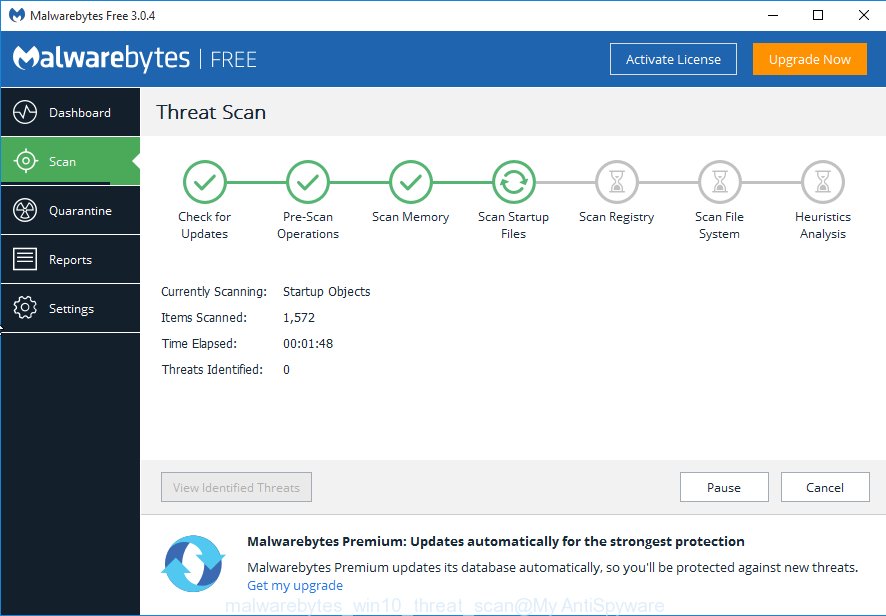
When the scanning is finished, the results are displayed in the scan report. All detected threats will be marked. You can delete them all by simply press “Quarantine Selected” button.
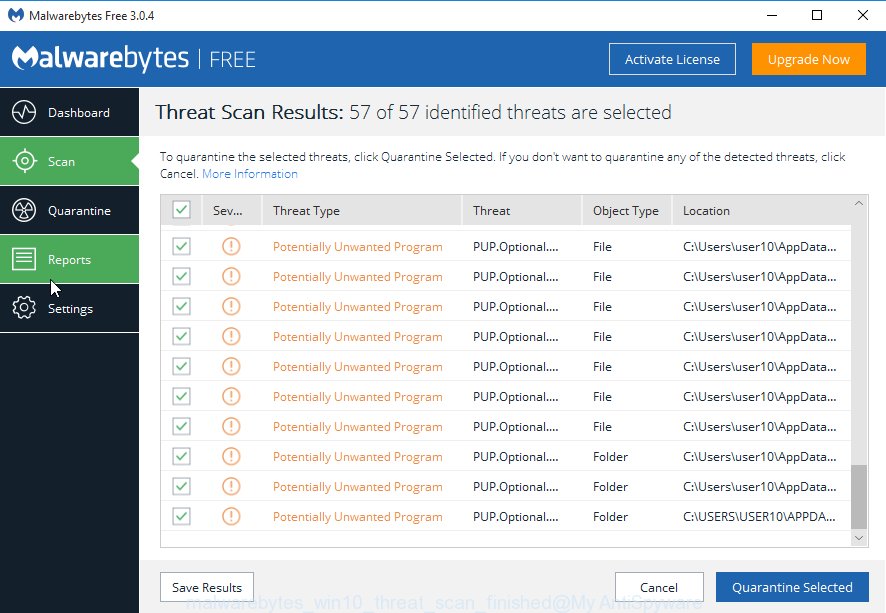
The Malwarebytes will now start to get rid of adware which shows misleading Ransomware Attack Warning Alert fake pop-up on your PC. Once finished, you may be prompted to reboot your PC system.
The following video explains step-by-step guidance on how to remove browser hijacker infection, adware and other malicious software with Malwarebytes Anti-malware.
Double-check for potentially unwanted applications with AdwCleaner
AdwCleaner is a free removal utility that can be downloaded and run to remove ad supported software that causes browsers to display misleading Ransomware Attack Warning Alert fake popup, browser hijacker infections, malware, PUPs, toolbars and other threats from your computer. You can use this tool to detect threats even if you have an antivirus or any other security program.
Download AdwCleaner tool by clicking on the link below. Save it to your Desktop so that you can access the file easily.
225642 downloads
Version: 8.4.1
Author: Xplode, MalwareBytes
Category: Security tools
Update: October 5, 2024
After the download is finished, open the directory in which you saved it and double-click the AdwCleaner icon. It will launch the AdwCleaner utility and you will see a screen as shown below. If the User Account Control dialog box will ask you want to show the program, press Yes button to continue.

Next, click “Scan” . This will begin scanning the whole computer to find out ‘ad supported’ software which cause misleading Ransomware Attack Warning Alert fake popup to appear. This procedure can take some time, so please be patient. While the application is scanning, you can see number of objects it has identified as threat.

When it has finished scanning is complete, it will show a list of all threats detected by this tool as on the image below.
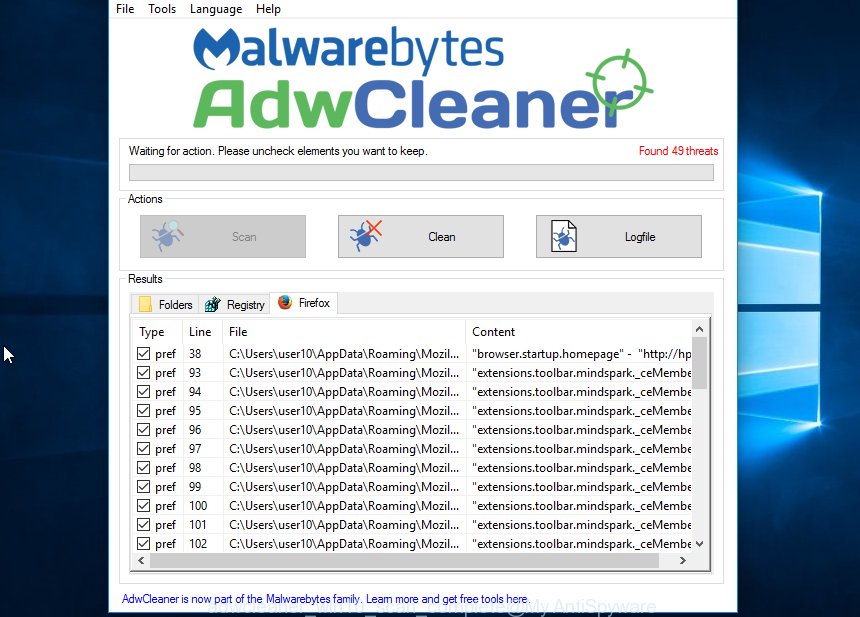
Next, you need to click “Clean” button. It will open a dialog box. Click “OK” button. The AdwCleaner will get rid of adware that causes browsers to show misleading Ransomware Attack Warning Alert fake pop-up error. After disinfection is finished, the tool may ask you to reboot your PC. After restart, the AdwCleaner will open the log file.
All the above steps are shown in detail in the following video instructions.
How to block Ransomware Attack Warning Alert pop-up
Use an ad blocking tool like AdGuard will protect you from harmful advertisements and content. Moreover, you may find that the AdGuard have an option to protect your privacy and block phishing and spam sites. Additionally, adblocker software will allow you to avoid intrusive pop-up advertisements and unverified links that also a good way to stay safe online.
- Download AdGuard program from the following link.
Adguard download
26905 downloads
Version: 6.4
Author: © Adguard
Category: Security tools
Update: November 15, 2018
- Once the download is finished, launch the downloaded file. You will see the “Setup Wizard” program window. Follow the prompts.
- After the installation is complete, click “Skip” to close the installation program and use the default settings, or click “Get Started” to see an quick tutorial that will assist you get to know AdGuard better.
- In most cases, the default settings are enough and you do not need to change anything. Each time, when you start your machine, AdGuard will launch automatically and block advertisements, web-sites such Ransomware Attack Warning Alert, as well as other malicious or misleading web sites. For an overview of all the features of the program, or to change its settings you can simply double-click on the icon named AdGuard, which is located on your desktop.
Tips to prevent Ransomware Attack Warning Alert fake pop-up
The ad supported software spreads with a simple but quite effective way. It’s integrated into the setup package of various freeware. Thus on the process of installation, it will be installed onto your personal computer. In order to avoid adware, you just need to follow a few simple rules: carefully read the Terms of Use and the license, select only a Manual, Custom or Advanced install mode, which enables you to make sure that the program you want to install, thereby protect your personal computer from the ad-supported software that cause misleading Ransomware Attack Warning Alert pop-up scam to appear.
To sum up
Now your personal computer should be clean of the adware that designed to display misleading Ransomware Attack Warning Alert fake popup within your browser. Uninstall AdwCleaner. We suggest that you keep AdGuard (to help you stop unwanted pop up ads and undesired harmful web sites) and Zemana Anti-malware (to periodically scan your personal computer for new browser hijackers, malicious software and adware). Probably you are running an older version of Java or Adobe Flash Player. This can be a security risk, so download and install the latest version right now.
If you are still having problems while trying to remove Ransomware Attack Warning Alert pop up error from the Google Chrome, IE, FF and MS Edge, then ask for help in our Spyware/Malware removal forum.

